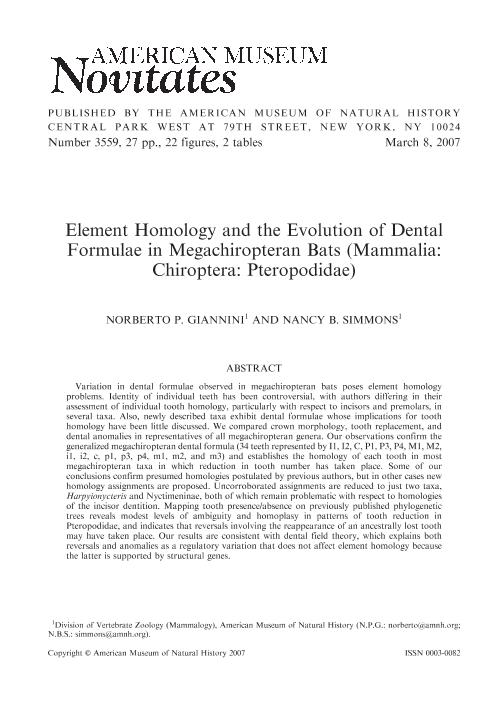Mostrar el registro sencillo del ítem
dc.contributor.author
Giannini, Norberto Pedro

dc.contributor.author
Simmons, Nancy B.
dc.date.available
2019-09-09T19:52:15Z
dc.date.issued
2007-12
dc.identifier.citation
Giannini, Norberto Pedro; Simmons, Nancy B.; Element homology and the evolution of dental formulae in Megachiropteran bats (mammalia: chiroptera: pteropodidae); American Museum of Natural History; American Museum Novitates; 3559; 12-2007; 1-27
dc.identifier.issn
0003-0082
dc.identifier.uri
http://hdl.handle.net/11336/83183
dc.description.abstract
Variation in dental formulae observed in megachiropteran bats poses element homology problems. Identity of individual teeth has been controversial, with authors differing in their assessment of individual tooth homology, particularly with respect to incisors and premolars, in<br />several taxa. Also, newly described taxa exhibit dental formulae whose implications for tooth<br />homology have been little discussed. We compared crown morphology, tooth replacement, and<br />dental anomalies in representatives of all megachiropteran genera. Our observations confirm the<br />generalized megachiropteran dental formula (34 teeth represented by I1, I2, C, P1, P3, P4, M1, M2, i1, i2, c, p1, p3, p4, m1, m2, and m3) and establishes the homology of each tooth in most<br />megachiropteran taxa in which reduction in tooth number has taken place. Some of our conclusions confirm presumed homologies postulated by previous authors, but in other cases new homology assignments are proposed. Uncorroborated assignments are reduced to just two taxa, Harpyionycteris and Nyctimeninae, both of which remain problematic with respect to homologies of the incisor dentition. Mapping tooth presence/absence on previously published phylogenetic trees reveals modest levels of ambiguity and homoplasy in patterns of tooth reduction in Pteropodidae, and indicates that reversals involving the reappearance of an ancestrally lost tooth may have taken place. Our results are consistent with dental field theory, which explains both reversals and anomalies as a regulatory variation that does not affect element homology because the latter is supported by structural genes.
dc.format
application/pdf
dc.language.iso
eng
dc.publisher
American Museum of Natural History

dc.rights
info:eu-repo/semantics/openAccess
dc.rights.uri
https://creativecommons.org/licenses/by-nc-sa/2.5/ar/
dc.subject
Skull Osteology
dc.subject
Chiroptera
dc.subject.classification
Zoología, Ornitología, Entomología, Etología

dc.subject.classification
Ciencias Biológicas

dc.subject.classification
CIENCIAS NATURALES Y EXACTAS

dc.title
Element homology and the evolution of dental formulae in Megachiropteran bats (mammalia: chiroptera: pteropodidae)
dc.type
info:eu-repo/semantics/article
dc.type
info:ar-repo/semantics/artículo
dc.type
info:eu-repo/semantics/publishedVersion
dc.date.updated
2019-08-29T15:42:47Z
dc.journal.number
3559
dc.journal.pagination
1-27
dc.journal.pais
Estados Unidos

dc.journal.ciudad
New York
dc.description.fil
Fil: Giannini, Norberto Pedro. Consejo Nacional de Investigaciones Científicas y Técnicas. Centro Científico Tecnológico - Tucumán. Unidad Ejecutora Lillo; Argentina
dc.description.fil
Fil: Simmons, Nancy B.. American Museum of Natural History ; Estados Unidos
dc.journal.title
American Museum Novitates

dc.relation.alternativeid
info:eu-repo/semantics/altIdentifier/url/http://digitallibrary.amnh.org/dspace/handle/2246/5849
Archivos asociados
